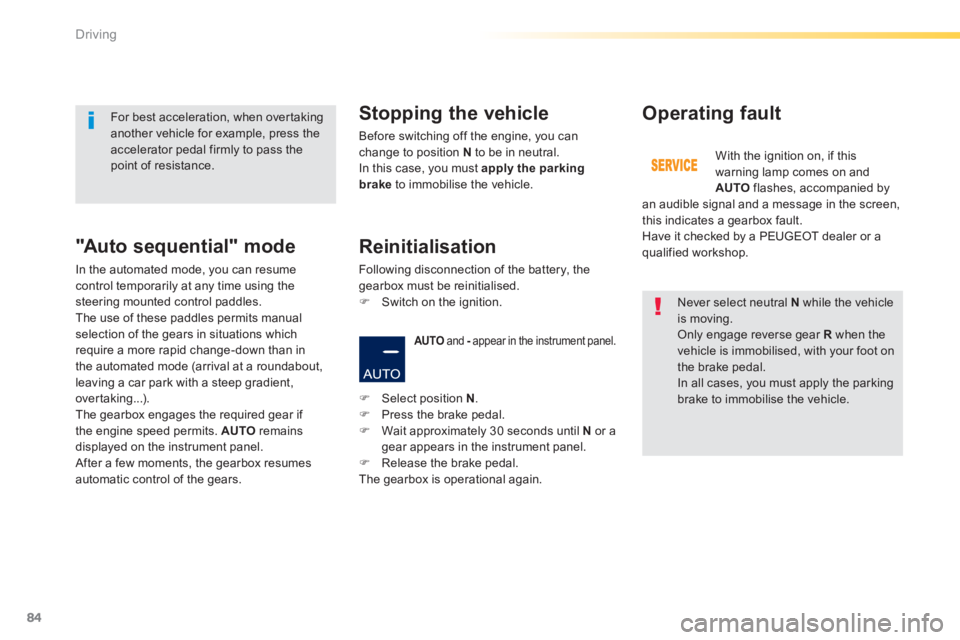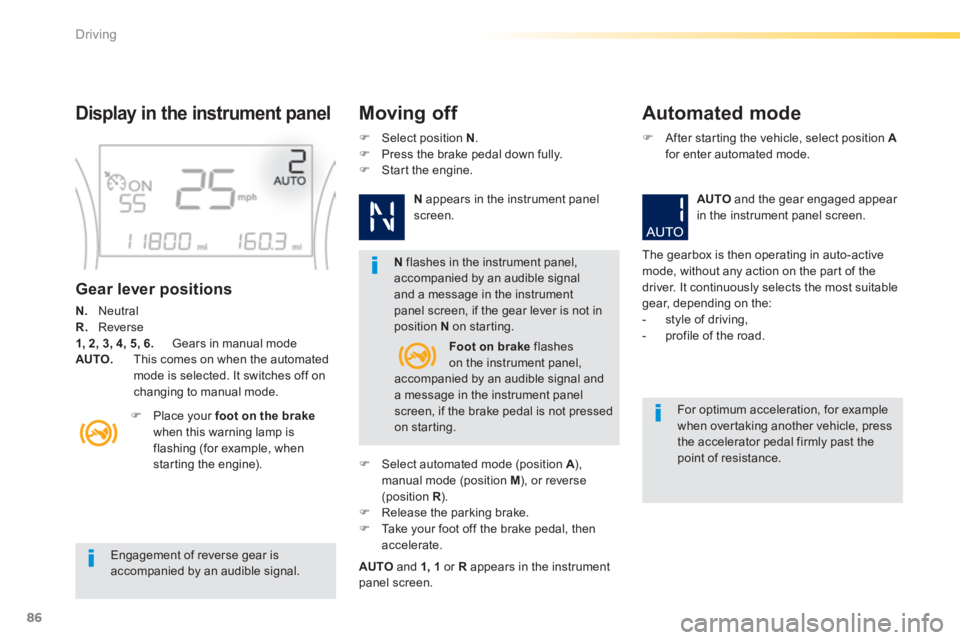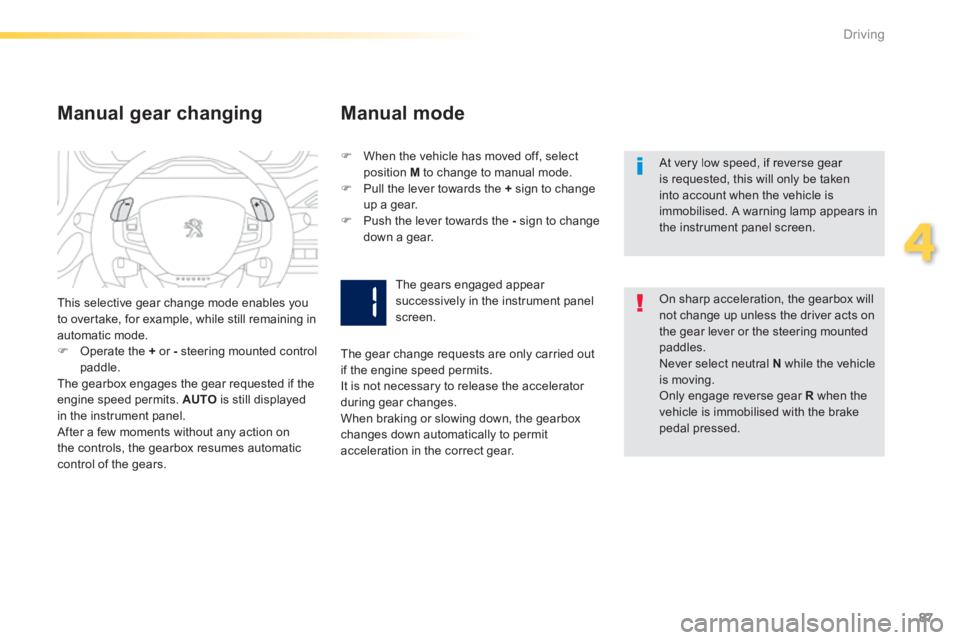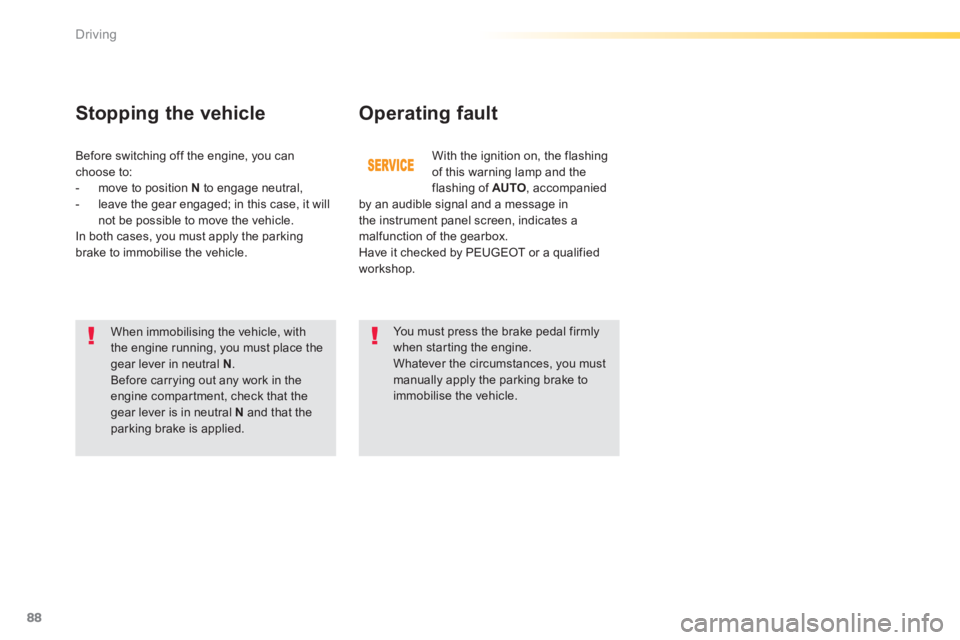2013.5 PEUGEOT 2008 instrument panel
[x] Cancel search: instrument panelPage 45 of 336

1
43
Monitoring
LCD instrument panel
Press this button to display the following settings successively: - hours, - minutes, - 12 or 24 hour format.
Setting the date and time
Press MENU to display the MAIN MENU then select " Preferences ". Select " Date & Time ".
Select the date or time displayed, use the keypad to adjust the setting, then " Confirm ".
Touch screen
Select " System configuration ".
Page 51 of 336

49
2
Access
Secondary control For mechanically locking and unlocking the doors in the event of a fault with the central locking system or a battery failure.
Driver's door
Insert the key in the lock to lock or unlock the d o o r.
Passenger doors
On the rear doors, check that the child lock is not on. Remove the black cap located on the edge of the door, using the key. Insert the key into the aperture without
forcing, then without turning, move the latch sideways towards the inside of the d o o r. Remove the key and refit the cap.
Changing the battery
Battery ref.: CR1620 / 3 volts.
Do not throw the remote control batteries away, they contain metals which are harmful to the environment. Take them to an approved collection point.
Remote control problem
Reinitialisation
Switch off the ignition. Turn the key to position 2 (Ignition) . Press the closed padlock immediately for a few seconds. Switch off the ignition and remove the key from the ignition switch. The remote control is fully operational again.
Following disconnection of the vehicle battery, replacement of the remote control battery or in the event of a remote control malfunction, you can no longer unlock, lock or locate your vehicle. First of all, use the key in the lock to unlock or lock your vehicle. Then, reinitialise the remote control.
If the problem persists, contact a PEUGEOT dealer as soon as possible.
If the battery is flat, you are informed by lighting of this warning lamp in the instrument panel, an audible signal and a message in the screen. Unclip the cover using a screwdriver in the cutout. Remove the cover. Extract the flat battery from its location.
Place the new battery into its location observing the original direction. Clip the cover in place.
Page 75 of 336

73
3
Comfort
Additional USB port
Depending on version, your vehicle may be fitted with a second USB port, located on the centre console. When in use, the USB por t / Jack auxiliar y socket must not be used to charge a por table device (risk of overload).
USB port / Jack auxiliary socket
This connection box, consisting of a JACK auxiliary socket and a USB port, is located on the centre console. It allows the connection of portable device, such as a digital audio player of the iPod ® type ® type ®
or a USB memory stick. It reads the audio files which are transmitted to your audio system and played via the vehicle's speakers. You can manage these files using the steering mounted controls or the audio system control panel and display them in the instrument panel screen.
When the USB port is used, the portable device charges automatically.
For more information on the use of this
system, refer to the "Audio equipment and telematics" section.
Page 85 of 336

83
4
Driving
Display in the instrument panel
Gear lever positions
N. Neutral R. Reverse 1, 2, 3, 4, 5. Gears in manuall mode AUTO. This comes on when the automated mode is selected. It switches off on changing to manual mode.
Select position N . Press the brake pedal fully. Start the engine.
Moving off
N flashes in the instrument panel screen if the gear lever is not in position N on starting.
Place your foot on the brakewhen this warning lamp flashes (e.g.: starting the engine).
There is an audible signal on engagement of reverse.
When moving off on a slope, accelerate
gradually while releasing the parking brake.
Select first gear (position M or A ) or A ) or Areverse (position R ) .R ) .R Release the parking brake. Progressively take your foot off the brake pedal, then move off.
AUTO and 1 or R appear in the instrument panel.
Stopping - Moving off on a slope
When stopping on a slope, do not use the accelerator to immobilise the vehicle; apply the parking brake.
Manual mode
AUTO disappears and the gears engaged appear in succession in the instrument panel.
After starting the vehicle, select position Mto change to manual mode.
The gear change commands are only carried out if the engine speed permits. When driving at low speed, on approaching a stop sign or traffic lights for example, the gearbox changes down to first gear automatically.
You must press the brake pedal firmly while starting the engine.
Automated mode
Following use of the sequential mode, select position A to return to the automated mode.
AUTO and the gear engaged appear
in the instrument panel.
The gearbox then operates in auto-adaptive mode, without any action on the part of the driver. It continuously selects the most suitable gear for: - optimisation of fuel consumption, - the driving style, - the road conditions,
- the vehicle load.
N appears in the instrument panel.
Page 86 of 336

84
Driving
Never select neutral N while the vehicle is moving. Only engage reverse gear R when the vehicle is immobilised, with your foot on the brake pedal. In all cases, you must apply the parking brake to immobilise the vehicle.
"Auto sequential" mode
In the automated mode, you can resume control temporarily at any time using the steering mounted control paddles. The use of these paddles permits manual selection of the gears in situations which require a more rapid change-down than in the automated mode (arrival at a roundabout, leaving a car park with a steep gradient, over taking...). The gearbox engages the required gear if the engine speed permits. AUTO remains displayed on the instrument panel. After a few moments, the gearbox resumes automatic control of the gears.
Stopping the vehicle
Before switching off the engine, you can change to position N to be in neutral. In this case, you must apply the parking brake to immobilise the vehicle.
AUTO and - appear in the instrument panel. - appear in the instrument panel. -
Operating fault
With the ignition on, if this warning lamp comes on and AUTO flashes, accompanied by an audible signal and a message in the screen, this indicates a gearbox fault. Have it checked by a PEUGEOT dealer or a qualified workshop.
For best acceleration, when overtaking another vehicle for example, press the accelerator pedal firmly to pass the point of resistance.
Select position N . Press the brake pedal. Wait approximately 30 seconds until N or a gear appears in the instrument panel. Release the brake pedal. The gearbox is operational again.
Reinitialisation
Following disconnection of the battery, the gearbox must be reinitialised. Switch on the ignition.
Page 88 of 336

86
Driving
Engagement of reverse gear is accompanied by an audible signal.
N flashes in the instrument panel, accompanied by an audible signal and a message in the instrument panel screen, if the gear lever is not in position N on starting.
For optimum acceleration, for example when overtaking another vehicle, press the accelerator pedal firmly past the point of resistance.
Display in the instrument panel Moving off Automated mode
Gear lever positions
N. Neutral R. Reverse 1, 2, 3, 4, 5, 6. Gears in manual mode AUTO. This comes on when the automated mode is selected. It switches off on changing to manual mode.
Place your foot on the brakewhen this warning lamp is flashing (for example, when starting the engine).
Select position N . Press the brake pedal down fully. Start the engine.
N appears in the instrument panel screen.
Select automated mode (position A ), A ), Amanual mode (position M ), or reverse (position R ). R ). R Release the parking brake. Take your foot off the brake pedal, then accelerate.
AUTO and 1, 1 or R appears in the instrument panel screen.
After starting the vehicle, select position Afor enter automated mode.
AUTO and the gear engaged appear in the instrument panel screen.
The gearbox is then operating in auto-active mode, without any action on the part of the driver. It continuously selects the most suitable gear, depending on the: - style of driving, - profile of the road. Foot on brake flashes on the instrument panel, accompanied by an audible signal and a message in the instrument panel screen, if the brake pedal is not pressed on starting.
Page 89 of 336

87
4
Driving
At very low speed, if reverse gear is requested, this will only be taken into account when the vehicle is immobilised. A warning lamp appears in the instrument panel screen.
Manual gear changing Manual mode
On sharp acceleration, the gearbox will not change up unless the driver acts on the gear lever or the steering mounted paddles. Never select neutral N while the vehicle is moving. Only engage reverse gear R when the vehicle is immobilised with the brake pedal pressed.
This selective gear change mode enables you to overtake, for example, while still remaining in automatic mode. Operate the + or - steering mounted control paddle. The gearbox engages the gear requested if the engine speed permits. AUTO is still displayed in the instrument panel.
After a few moments without any action on the controls, the gearbox resumes automatic control of the gears.
When the vehicle has moved off, select position M to change to manual mode. Pull the lever towards the + sign to change up a gear. Push the lever towards the - sign to change
down a gear.
The gears engaged appear successively in the instrument panel screen.
The gear change requests are only carried out if the engine speed permits. It is not necessary to release the accelerator during gear changes. When braking or slowing down, the gearbox changes down automatically to permit acceleration in the correct gear.
Page 90 of 336

88
Driving
Operating fault
When immobilising the vehicle, with the engine running, you must place the gear lever in neutral N . Before carrying out any work in the engine compartment, check that the gear lever is in neutral N and that the parking brake is applied.
With the ignition on, the flashing of this warning lamp and the flashing of AUTO , accompanied by an audible signal and a message in the instrument panel screen, indicates a malfunction of the gearbox. Have it checked by PEUGEOT or a qualified workshop.
You must press the brake pedal firmly when starting the engine. Whatever the circumstances, you must manually apply the parking brake to immobilise the vehicle.
Stopping the vehicle
Before switching off the engine, you can choose to: - move to position N to engage neutral, - leave the gear engaged; in this case, it will not be possible to move the vehicle. In both cases, you must apply the parking brake to immobilise the vehicle.